Back in 2009 I collated a bunch of different ideas from teachers and educators on the LEGOengineering mailing list on how they store their LEGO in class. It was originally turned into a pdf but wasn’t easy to find, so I thought I’d reproduce it here and link it in a few more places.
Do you use any of these methods? Something completely different?
When asked “How do you store your LEGO?” there is no single correct way that suits every classroom. What follows below is a collection of different ideas that were gathered together from teachers from all over the world via the LEGO engineering mailing list. This mailing list has over 200 participants, exchanging ideas about how robotics is taught in schools. Please join us and help grow the community of robotics educators.
Karen Rouse Technology Coordinator Pacific Pines Primary
Here at Pac Pines we currently have 12 RCX & 4 NXT robotics kits. Students in Years 4 to 7 participate in robotics programming activities at before and after school clubs. Because our club activities are mainly programming based challenges at the moment the students generally just use pre-built robots.
ROBOT ORGANISATION
 The robots have all been given a name and the students have laminated and attached name cards to each robot like a number plate (see Bizzy & Bella Close Up – pic attached). The robots have a set parking spot (also named) on a shelf in our Tech Lab where they always go back to when they are not being used (Robot Parking pic attached). Because our Tech Lab is in our library and the robotics storage area is in a corridor between the two it is a high traffic area where many little fingers might like to play with the robots so to avoid that as much as possible we add covers to the front of the Robot Parking area when robotics is not on (see Robot Parking Covers pic attached).
The robots have all been given a name and the students have laminated and attached name cards to each robot like a number plate (see Bizzy & Bella Close Up – pic attached). The robots have a set parking spot (also named) on a shelf in our Tech Lab where they always go back to when they are not being used (Robot Parking pic attached). Because our Tech Lab is in our library and the robotics storage area is in a corridor between the two it is a high traffic area where many little fingers might like to play with the robots so to avoid that as much as possible we add covers to the front of the Robot Parking area when robotics is not on (see Robot Parking Covers pic attached).
LEGO PIECES STORAGE
As far as storage of the many Lego pieces goes, we use sets of storage trays on wheels and group like objects together in each tray (see Storage Trays pic attached).
We have a tray for each of the following:
- Beams
- Plates
- Bricks / Pegs / Bushings (pegs and bushings just went in with the bricks because this tray had lots of space)
- Gears / Axles / Belts & Pulleys
- Connectors
- Wheels
- Motors, Sensors, Lights,
- Wires
- Miscellaneous
- Stationary
This is just the way that the pieces seemed to best fit when we first bought the trays (very cheap from IKEA) but I have a feeling that as we continue to grow our robotics resources I will need to do some re-organising – we’ll see.
Inside each main tray there are smaller storage containers for the individual pieces (see Storage Containers pics attached). Most of the smaller storage containers have a photo and description of the individual Lego piece that belongs there which helps the students identify the pieces they are looking for more easily and also return them to the correct place. This system works well for us because as I said earlier the majority of our robots stay pre-built for students to program with and when students do get some time to build attachments, modify robots or create new robots it is only one or two students or a small group at once that do this and need to access the pieces. The trays have double sided access (can slide out either way) which also helps when a few students are trying to find things at once. After students have done some building and there are pieces left over they don’t always put them away straight away -they just get chucked into a “Pieces to Sort” box and someone will do it when they have spare time and there is always some helpful student eager to do this which is great!
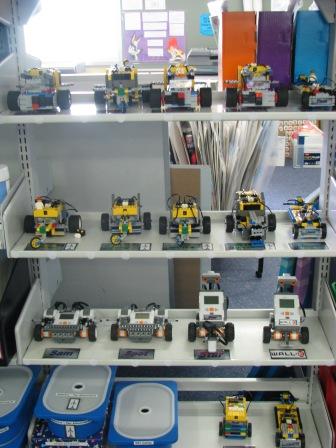
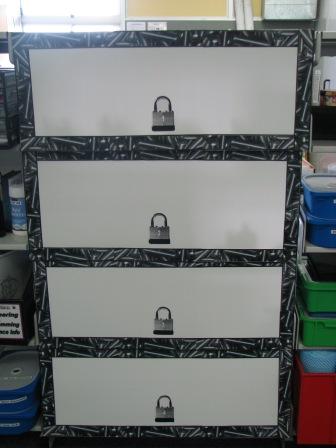
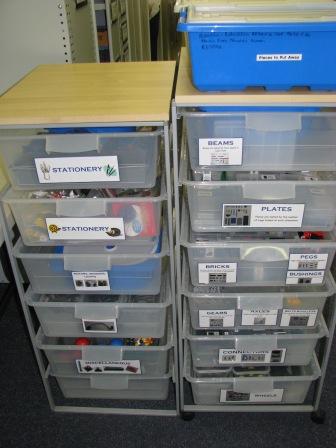
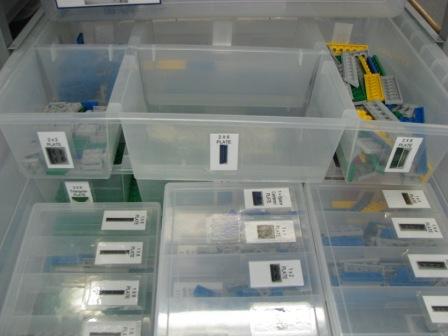
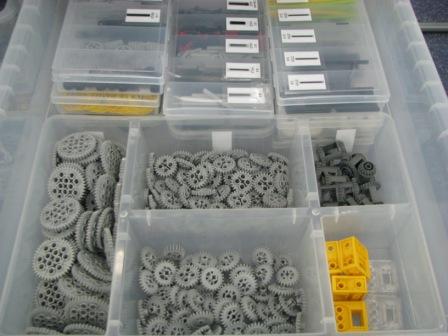
Jeanette Fitzmaurice Robotics Club St Pius X College Chatswood, NSW
We have had an after school Club for about 8 years now. We have 40 boys, Years 6 to 12, working with 15 NXT kits plus probably as many old RCX kits.
We store the pieces, sorted, in the grey trays that come with the NXT kits (see 6). This way, when stacked, they take up less room in the cupboard (see 1 & 2).The boys return pieces to mixed boxes (see 7). We have some wonderful mums who sort these pieces while their sons build!
The NXT bricks, motors, sensors etc are kept in smaller plastic containers, again without lids so that they stack inside each other (see 4). These pieces are numbered and the boys sign for them as they take them (see 5).
The teams themselves use A4 cardboard boxes to store their robots and bits and pieces in another cupboard (see 3).
We had a power point installed in the back of one cupboard (see 2) and batteries are left charging here. Boys just swap over batteries when needed.
There are another 10 NXT kits used by classes during the day. These are kept as fully built NXTs and “parked” on a shelf in a separate cupboard(sorry no photo), with all extras in an NXT kit tray. These classes only programme.
Looking at the pics now it looks a bit higgeldy-piggeldy but the boys do all the putting away themselves and it works like a charm!
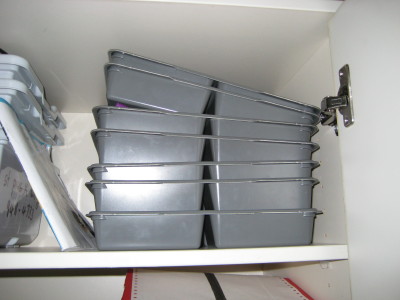
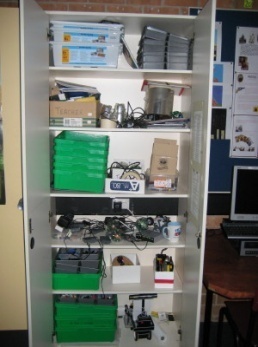
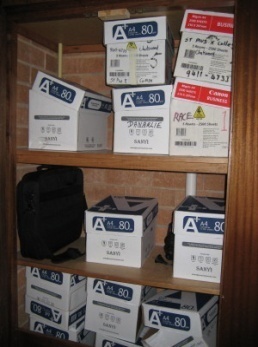
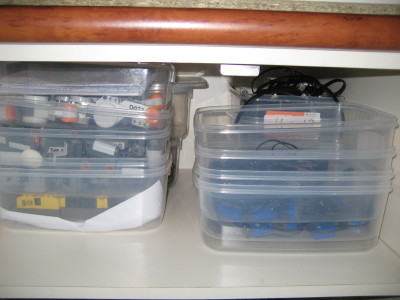
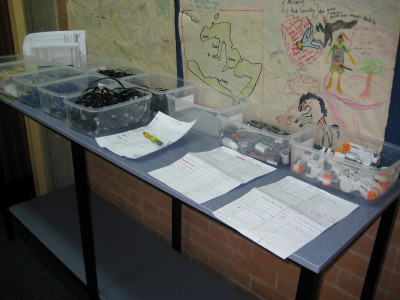
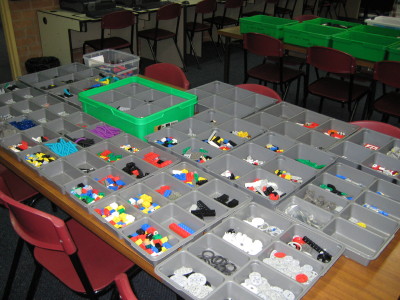
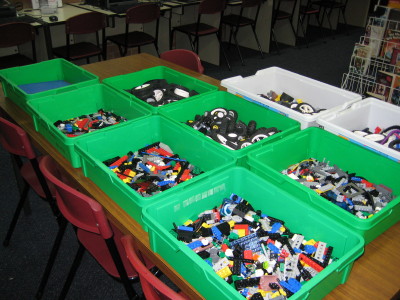
Dr Graeme Faulkner – http://www.drgraeme.net/default.htm
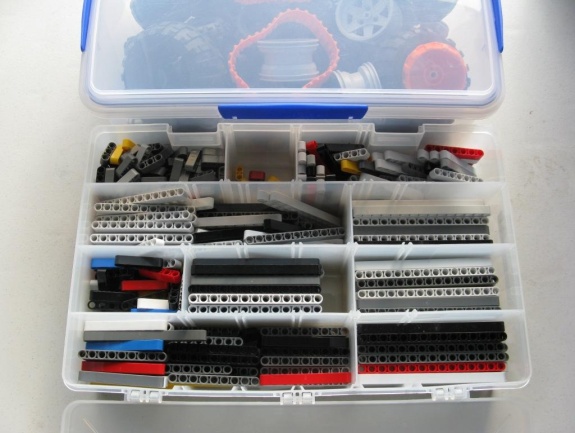 The several Tasmanian schools at which I mentor store their NXT kits in their original boxes.
The several Tasmanian schools at which I mentor store their NXT kits in their original boxes.
This is probably because they only have a few sets each (generally 2 to 10), and it is easier to check on the set contents at the end of each course.
Responsibility for missing pieces varies with the School, some (theoretically at least) holding the students responsible for missing pieces, some not.
Personally, I use fishing tackle boxes (obtained from Kmart) for the pieces that are more numerous, and bin boxes for the less numerous & “weirdo” pieces.
Deborah Bean, STEPPS and Wrobotics Facilitator Montclair and Willowdale Elementary Schools Omaha, NE.–USA
I keep them sorted in small compartments by type (axles, outputs, inputs, connectors, etc.) It saves a lot of time finding the correct parts. I found that using the boxes from Lego used up too much space and made finding the correct parts a chore. Sorting them does take some time and patience initially, but it saves so much time later when we need to find a part. It also seems to help students know what parts are available, and helps them to classify them in their minds.
I have used this system for both the RCX and NXT–even the old Control Lab–parts from Lego. I work with students in small groups, but feel that it would work for bigger groups as well. The boxes I use are inexpensive, and easily found at hardware or fishing tackle stores.
I keep most of the parts in storage closets, but do have NXT parts that we use frequently on a rolling cart.
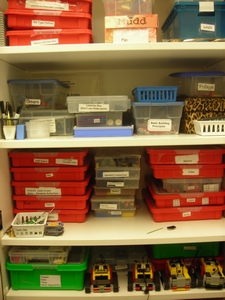
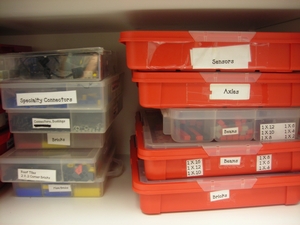
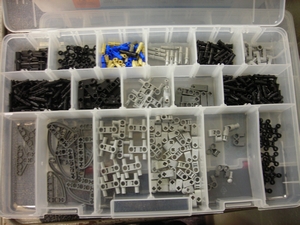
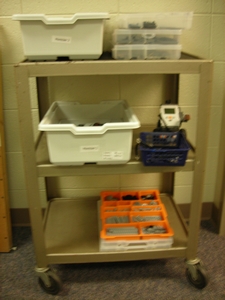
David Herman, New Albany High School and Eastland-Fairfield Career & Technical Schools
I use a custom storage case created by Robotics Learning. (http://www.roboticslearning.com/store/storage-nxt-fll.html).
Each bin has a picture of the part, and the proper inventory count. It holds the combined resources of a Lego Education Base Set and a Lego Education Resource Set.
Each team (based on the project) gets the use of one or two cases. Helps me enforce organization and parts accountability, as well as the competition-style discipline of staying within a finite set of parts.
Matt Skinner- Mackay SHS – Australia
I keep each kit in its box provided. Each student uses the one kit for the year (I don’t have to share kits across classes ). Each kit and NXT has a kit number sticker on it. At the end of each year, we dismantle everything and I give each student an A3 photocopy of the cardboard top section that shows all pieces and how many there should be. We audit each kit. Usually, everyone has parts missing and excess parts which we redistribute. Overall, no missing parts.
Kits are stored on shelving in a staffroom, with chargers recharging all 21 kits (we procured kits with the LiON batteries).
David Levy- Reston Robotics
I use the original NXT tubs from Lego Education for courses ( I have ten of those now). For long term projects and FLL , my team uses plano boxes to consolidate several retail kits. see – http://thenxtstep.com/repository/planos/index.htm
Josh Hubbard – Inter-City Baptist HS, Allen Park MI
I use the original bin they came in. I assign one per student or group depending on the size of the class. I keep the additional parts that I have purchased (Edu. Resource kits) in one bin that is divided by part type. At the end of the year we check to make sure every kit has all the parts it should have and none that it shouldn’t.
Amy Eguchi, PhD, Assistant Professor of Education – Bloomfield College
What I do with my afterschool/elementary school students (I teach robotics at The School @ Columbia Univ.) is to put similar items in the same bin. We also have a bin for each team to store their robot and pieces that they need.
The bins are all stored in a cabinet (huge). Some oversized robots (those do not fit in the bin) are stored on top of the cabinet so that no one can touch during the school period.
With my undergraduate students, each set is kept as is. At the beginning of each semester, students sort out pieces and create a complete set. They, then, as a group, they use it throughout a semester. Because the focus is heavily on programming with this course, they do not do much building. So they do not really need pieces during the semester until they start their final project towards the end.
Alexander Ho – LEGO Education Coordinator, Innova Primary School, Singapore
We have just started our robotics club this year with 11 NXT kits. I currently store my NXT kits in the original Lego Education boxes that they came in. For the extra sensors that we got, I store them in clear plastic boxes. The work-in-progress and completed robots are stored in clear plastic boxes. Everything is stored in cabinets.
We are in the midst of renovating a LEGO education room. Until then, we will are just using a normal classroom.
Susan Bowler, Ogilvie HS – TAS, Australia
I have two sets of kits: NXT and RCX.
I have tried to use the RCX as individual kits and also as grouped by parts in bins and plastic bags.
If you group them in bins, make sure the kids put the parts back in the bins, and allow yourself time to check that they are no being mixed up before dismissing them. If not, you will have mess at the end of the semester. I have gone back to individual kits for the RCX and also the NXT.
I store extra bits and parts by type in separate containers.
I am still recovering from mass storage used last year. It requires a lot of room and a dedicated lab, in my opinion. I do not have that luxury, unfortunately. Maybe in a couple of years as our program grows.
Andrew Blackwell, Information Technology Teacher – Newcastle Grammar School
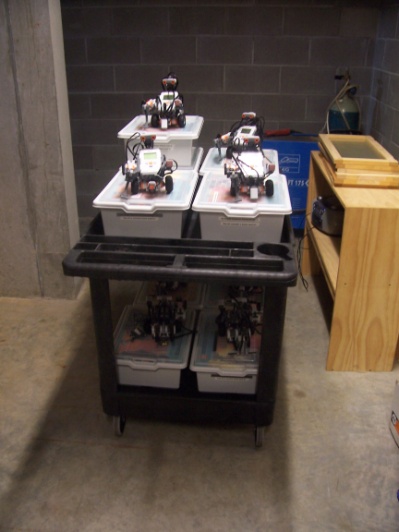 I have just begun implementing Lego robotics into Technology in our school. We have purchased 37 Nxt kits and 3 resources kits. Our projects range from each year. At the moment I have stored them in our store room and the kits that the students are using are wheeled out into the class on a trolley.
I have just begun implementing Lego robotics into Technology in our school. We have purchased 37 Nxt kits and 3 resources kits. Our projects range from each year. At the moment I have stored them in our store room and the kits that the students are using are wheeled out into the class on a trolley.
At the end of the 13 week unit the students check that they have each part and I have made them sign a contract which states they will look after the kits.
Download the original pdf – How do you store your LEGO?
2 Comments
Comments are closed.

I like lego storage containers,I love this… thanks for sharing.
lego storage containers
I like lego storage containers,I love this… thanks for sharing.
lego storage containers